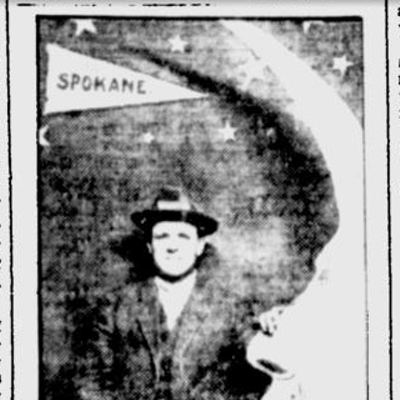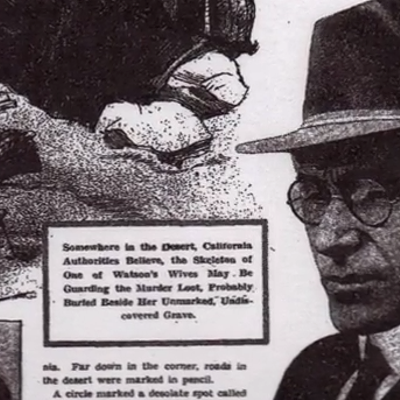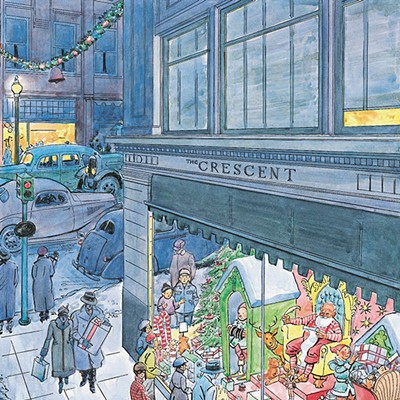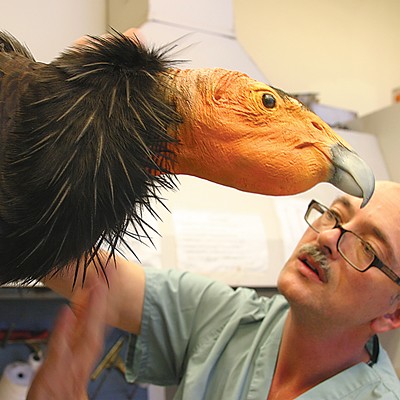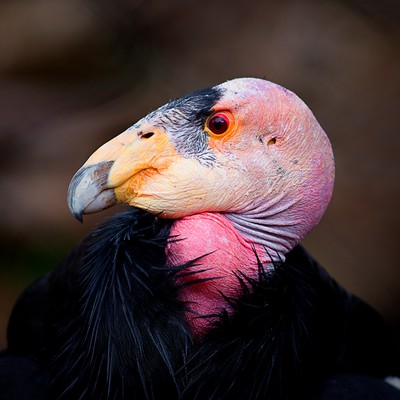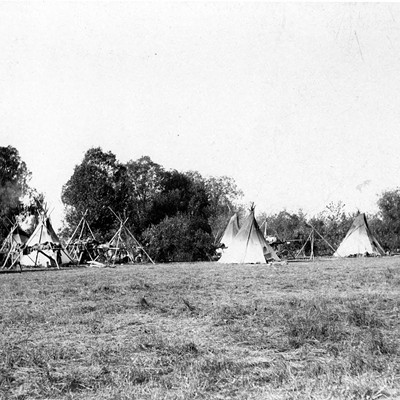One of the great characters of the early fur trade days in the Columbia District was Finan McDonald, whose 20-year career here began with the establishment of Kootanae House at the source lakes of the Columbia in 1807 and ended just after Spokane House was abandoned in 1826. Because McDonald never rose above the level of a company clerk, today we know him mostly through other people's terse trade journal entries and romanticized reminiscences, which make it hard to get a clear idea of what the man might actually have been like. But Finan could wield a pen himself, and a handful of remarkably misspelled letters plus one turn at a house journal reveal aspects of someone who has to be included on any list of early shapers of the Inland Northwest.
Born into a military family from Aberdeenshire, Scotland, in 1782, Finan's father and mother emigrated to Glengarry County, a Scottish enclave near Montreal, when he was four years old. Nothing else is known of his early life until 1804, when at the age of 22 he entered the service of the North West Company. Within two years Finan had been posted to Rocky Mountain House, far up the Saskatchewan River. Between 1807 and 1812 he served as David Thompson's second-in-command, playing a key role as the Nor'Westers established a circle of trade houses that stretched from the source lakes of the Columbia River south into Western Montana and Eastern Washington. Thompson's brief mentions of "Mr. McDonald" depict Finan carrying supplies back and forth over the Rocky Mountains, spearing a trumpeter swan for supper, losing a bag of musket balls along the trail, and paddling upstream with Thompson's wife Charlotte in the spring of 1808.
By that fall, Thompson, who had at first been wary of his clerk's lack of experience, placed enough faith in Finan's abilities to dispatch him down the Kootenai River to establish a winter post among Lower Kootenai bands in what is now the Idaho panhandle. Despite harsh winter conditions that stopped him short of his destination, McDonald did spend the winter of 1808-09 at a "Hangard" he erected east of present-day Libby, Mont. He made good receipts of beaver there, and recent archaeological work may establish this post as the earliest trade house in western Montana.
In fall 1809, it was Finan who hung the door at David Thompson's newly completed Kullyspel House on Lake Pend Oreille, and McDonald again who made a profitable trade when Coeur d'Alene people brought in their pelts while Thompson was exploring downstream. When the Salish-speaking and Flathead bands moved upstream on the Clark Fork to their winter camps, McDonald became part of the crew who followed them to build Saleesh House near modern Thompson Falls, Mont. He spent the next three winters between the Kullyspel and Saleesh Houses, and at some point he began to live with a Kalispel country wife; tradition has it that she was the daughter of a chief the traders called "Chin-Chay-Nay-Whey." Her name among white people was Margaret, usually shortened to the common nickname Peggy.
Into Spokane Country
Late in the fall of 1810, McDonald and two of his North West Company cohorts accompanied a Salish party east of the Divide to hunt buffalo. While on the Plains, they skirmished with a group of Blackfeet. During the fracas, the Nor'westers fought alongside the Plateau people, firing off many rounds and inflicting some casualties. This infuriated the Blackfeet, and fear of retribution might have made McDonald feel vulnerable when he returned to Saleesh House post. During the winter, he moved west to Kullyspel House and then south into the Spokane country, where David Thompson had instructed Jaco Finlay and a crew of voyageurs to construct a new trading post.
There is no record of when McDonald arrived at this Spokane House, located just below Nine Mile Falls, or how much work he may have contributed to its original buildings. What is known is that in the spring of 1811 David Thompson, after pioneering the Athabasca Pass trade route in the dead of winter, worked his way south, rendezvoused with McDonald in June. From Spokane House, they led pack horses north through the Colville Valley to the great salmon fishery at Kettle Falls. After Thompson build a canoe and shoved off on his historic journey to the Pacific Ocean, Finan was charged with scouting the Columbia River from Kettle Falls upstream clear to Boat Encampment, at the river's northernmost bend. He may have been the first white fur trader to travel those 250 river miles, but left no field journals that survive for this or any of his other exploratory treks.
McDonald was based at Saleesh House again for the winter of 1811-12, and spent much of his time parlaying with local bands for food and furs. He served as point man for David Thompson's trips to Missoula and Flathead Lake, gathering pelts at Salish and Kootenai tribal encampments in the Jaco River drainage while his boss completed rough surveys. In Thompson's daybook of February and March, 1812, the familiar "Mr. McDonald" seems to mark every trade transaction and trail juncture.
"A Wild and Uncouth Appearance"
After David Thompson retired from the Columbia country in spring 1812, an Irish clerk named Ross Cox appeared on the scene. Employed first by John Jacob Astor's Pacific Fur and then by the North West Company, Cox worked for several years in the interior before retiring back to Ireland; his narrative The Columbia River was written in Europe and published in London in 1831. The book contains far more words about Finan McDonald than any other single source, and includes Cox's famous physical description of the man.
His appearance was very striking: in height he was six feet four inches, with broad shoulders, large bushy whiskers, and red hair, which for some years had not felt the scissors, and which sometimes falling over his face and shoulders gave a wild and uncouth appearance... To the gentleness of a lamb he united the courage of a lion. He was particularly affectionate to men of small size, whether equals or inferiors, and would stand their banterings with utmost good-humour...
Ross Cox took his first trip inland in the fall of 1813, as part of a North West canoe brigade that included Finan McDonald. A quarrel with tribal people during their portage at the Dalles degenerated into a confused hostage situation, and according to Cox's animated account it was Finan's steadfast courage that allow the traders to pass upstream. The following fall, Cox described a similar incident at the Cascades of the Columbia, with McDonald fearlessly standing up to tribal bullies and coming away unscathed. Since these portages often involved much posturing between local residents and fur traders, it is hard to gauge the degree of real danger in Cox's stories, but there is no doubt that McDonald was quick to take a stand.
Over the next three years, Cox counted off Finan's several postings in the Columbia District, poking fun at the giant's spluttering attempts to express himself while showing his admiration for a local hero of mythic proportions.
He seldom remained more than one winter at any particular place, and had a greater facility of acquiring than of retaining the language of the various tribes with whom he came in contact. He was subject to temporary fits of abstraction, during which the country of his auditory was forgotten, and their lingual knowledge set at defiance by the most strange and ludicrous melange of Gaelic, English, French, and half a dozen Indian dialects...He was however a goodnatured, inoffensive companion, easily irritated, and as easily appeased.
Cox's view of Finan's country wife (whom he identifies as a Spokane), and his relationship with his tribal family, was equally romanticized.
He had taken a spokan wife, by whom he had two children. A great portion of his leisure time was spent in the company of her relations, by whom, and indeed by the Indians in general, he was highly beloved. Their affection however was chastened by a moderate degree of fear, with which his gigantic body and indomitable bravery inspired them.
Although Cox may have inflated the truth of McDonald's role in various tribal tussles, the two did work together for the North West Company for several years, and a letter from agent Donald Mackenzie to Cox, posted from the Snake River country in February 1817, confirms their close relationship: "I passed an agreeable time with our friend Finan. He is certainly a most worthy mortal and desires to be remembered to you."
"Avery One's Foot Bole"
Finan McDonald's own writings reveal a more complicated man, full of frustration and regrets with the everyday trials of fur trade life. In an 1815 dispatch from Fort Kamloops, he described his trip upriver from Fort Vancouver, the trade of the year, the hiding he gave an Indian horse thief, and personal complaints about the food and unjust treatment he seems to be receiving from his fellow furmen -- Finan may not have enjoyed his role as a good-natured galoot as much as Ross Cox seemed to think. In the letter, McDonald's handwriting is reasonably clear, and if the lack of punctuation and phonetic spelling make it difficult to read, his expressive phrasing get his intentions across very clearly. I am pretty sure he is the only fur trader who ever used the word "football" in an official business document.
I have nosion in my heade to Leave this part of the Cuntre I am tierd of Eating Rottin Salmon since 4 years ago that I am in this Cursed part of the Cuntre Besides other things that laying on me which Mr. McMillin will tell you I only say that I am averey one's foot Bole if it was in another part of the World they wood dar not doe it as here we must take the warld as it Comes -- it will be day to drow accounts and a day to pay.
(TRANSLATION: I have a notion in my head to leave this part of the country. I am tired of eating rotten salmon since the four years I have been in this cursed part of the country. Besides other things laying on me, which Mr. McMillan [the chief agent] will tell you, I only say that I am everyone's football. If it was in another part of the world they would not dare to do it, but here we must take the world as it comes. There will be a day to draw accounts, and a day to pay.)
In a letter from Spokane House dispatched to Columbia District chief factor John McTavish in April 1819 (and here translated into something close to modern English), McDonald described as much discontent with his job location in Spokane as he had four years previously in Kamloops.
I bound myself for three years last spring to remain on this side of the Mountains, [but] I assure you that I am getting tired of this side. I would be very happy to be a couple of years on the other side to play with the English to know what they are made of. It was partly against my will that I remain for such a long time.
He made his relations with the local Salish tribes, especially the Spokane, sound far from beloved.
For my part this is the last place that I would wish to pass the spring in the whole country. I am not fond of the natives and they are still less fond of me.
Finan also suggested struggles with family and finances that neither Ross Cox nor later historians ever touched on.
I am sorry that you were so late in giving your advice about Peggy and not having children. I had one on the stocks ready to be launched when I got your advice. It can't be helped -- it is adding one more to the family. More the merrier. A fool is able to gain money, but it is a wise man that is able to keep it. Which I am a Fool. I have no more to say.
"Peggy" is surely Margaret, his Kalispel wife, with whom McDonald apparently fathered at least five children. Both Finan's "fool-and-his-money" aphorism and his reference to advice from his boss hint at the deep social and economic significance of mixed blood fur trade families and the way they played out from the rank of voyageur to clerk, agent to factor.
Fisherman, Gardener
As a veteran in the trade, McDonald would have kept an alert ear for the latest twists of company policy. In the same 1819 letter, he mentioned to McTavish his assumption that Spokane House would soon be abandoned for a new post at Kettle Falls, and wondered what his place might be in the new order. Although North West Company partners must have been discussing such a move at that time, Spokane House remained the central inland post of the Columbia District as the Hudson's Bay Company absorbed the North West franchise over the next two years. It was only in 1825 that HBC governor George Simpson finally gave the order to construct the new Fort Colvile at Kettle Falls, and Spokane House was abandoned.
Finan McDonald wrote another letter to McTavish from Spokane House in 1820, and first appeared on the employee pay list of Hudson's Bay Company during the season of 1821-22. Although he may well have been posted at Spokane House during this period, it was not until the following year that real proof of McDonald's activities comes to light. The opening entry of the Spokane House Journal for 1822-23, begun in April 1822, has a distinct tag line written sideways down the left-hand margin of the page: KEPT BY FINAN MCDONALD.
This document, the only surviving journal for the 15-year run of Spokane House, is full of terse but pithy insights into Finan's world. Almost as soon as he listed out the roster of who was present at the post and where the other traders and voyageurs were headed, McDonald turned his attention to spring gardening. The fact that there were more women and children living at the post than men helped provide him with a crew.
Wednesday 17th
Examined our seed potatoes in the Cellar and found them to be far short of my expectations
Friday April 19
All the men and women belonging to the fort employed digging & amp; preparing a piece of new ground & amp; likewise the old piece of ground for the purpose of planting our potatoes.
Friday May 3
All hands employed planting potatoes put in the ground today ten Kegs cut which with 8 1/2 Kegs planted before make 18 1/2 planted altogether
May 4
People employed finished the fences of the gardens.
Every day Finan checked the fish trapped in two elaborate weirs or "barriers" that had been anchored near the confluence of the Little Spokane and Spokane River: one belonging to the Spokane people, and one set up by the North West Company furmen but operated by a tribal member from Kettle Falls. From spring steelhead and trout through runs of summer chinook and and fall coho salmon, Finan methodically counted off the catch each day. Whenever big runs were taking place, the Spokane weir always caught more fish, and he often recorded a trade for some of the tribal bounty.
McDonald paid close attention to the horses, also counting them regularly. He tracked the company's animals against ones owned by specific voyageurs, and engaged one of his best men to drive the herd up the Little Spokane River and across to Peone Prairie to graze. Since goods and pelts were constantly being packed downstream to the confluence of the Spokane and Columbia Rivers, the company needed a lot of fresh horses, so Finan often had to negotiate with tribal people for extra stock; there was nothing strange about a band of Nez Perce appearing at the post with a string of horses, ready to deal.
During the course of the year, no less than 10 different named tribes visited Spokane House. McDonald recorded their mysterious ebb and flow in the logbook, beginning with the spring root gathering in April. It was his job to determine the exchange value when tribal people brought in meat, berries, and other necessaries that kept the fur traders alive.
Freemen, company voyageurs, and traders also came and went frequently, staying over for varying amounts of time and sometimes becoming a burden on the post. At one point, McDonald had to accept into his care a number of company men from Fort George (at the mouth of the Columbia) who were so disabled with venereal disease that they could not work at all. Even so, from April to late July, the journal displayed few hints of Finan's famous temper; it reads much more as a steady record in the standard fur trade tradition of business, weather, work performed, and movements of people.
Then, on July 22, after taking stock of what was on hand at the post, Finan signed his duties over to James Birnie, a young clerk much more suited to the sedentary life. Within two weeks McDonald and fellow clerk William Kittson had departed from Spokane House to the Pend Oreille country, perhaps to reunite with Peggy's Kalispel family as well as to gather pelts. McDonald soon returned to Spokane House, however, and on August 28, James Birnie recorded a striking instance of Finan's passion involving fish, ownership, and garden fences.
August 28
This morning as Mr. Lewes & Mr. McDonald went down to see our barrier, there happened to be some of the indians there spearing the salmon coming up the river. Mr. McD spoke to them but they being in a canoe, put all his threats at defiance. he lost no time in springing into the water & broke the canoe. The Chief of the place was much displeased and went and broke down nine of the palisades of the garden. his brother being more attached to the whites went and drove him away from the garden.
Birnie did not explain why Finan thought he had rights to all the fish in the Little Spokane River, or how deep the water was, or exactly how McDonald broke the spearman's canoe. He did not comment on the perfection of the Spokane chief's retaliation in tearing down Finan's precious garden fence, or the fact that the Nor'westers took the unusual step of posting a guard that evening in case the incident heated up again. In the next day's journal entry, Birnie recorded business as usual, and neither the broken canoe, the dismantled fence, nor anyone's fishing rights were ever mentioned again.
Precious Cargo
Over the ensuing winter, Finan McDonald remained mostly absent from Spokane House, but in spring 1823, he was named in chief agent Alexander Kennedy's annual report as leading a group of 52 trappers (including several native Hawaiians) south for the annual Snake River expedition. This notoriously difficult duty involved exploiting an unfamiliar landscape, trespassing on tribal territory, and inevitable conflict with the Americans who were pushing west through various Rocky Mountain passes. Hudson's Bay Company agent Alexander Ross later wrote that McDonald performed as well as a man could under the circumstances, but also gave an account of a series of skirmishes with Shoshone bands that killed seven of Finan's men -- a shocking loss compared to the Company's peaceful relationships with Salish-speaking tribes.
Upon his return, McDonald may have wintered at Spokane House, and certainly departed from there with Peter Skene Ogden in April 1824. Although Finan returned to Spokane House again that fall, he spent at least part of 1825 downriver at Fort Vancouver. The botanist David Douglas was in the area as well, and in his writings, mentions meeting McDonald at Multnomah Falls when Finan was on the way to the Willamette to hunt. Douglas must have been impressed with Finan's character, because when their paths crossed again near Walla Walla in June 1826, the botanist trusted the clerk to carry a trunk of his precious seed and plant collections downstream to Fort Vancouver.
That fall, when Finan finally retired from the Columbia country and headed upstream to cross Athabasca Pass on his way to lower Canada, he carried David Douglas's trunk along with him. Peggy and four of their children also made the journey, as McDonald became one of the few fur trade clerks to take his mixed blood family east after their retirement. Somewhere beyond Boat Encampment, the Columbia's northernmost turn point that Finan had first seen in 1811, the McDonalds ran into another traveling botanist named Thomas Drummond, famous for his travels with Sir John Franklin's Arctic expeditions. As the scientist and the blustering fur trade clerk made their way across Athabasca Pass, Drummond gained knowledge and a taste of the Finan legend.
On my journey, I met with Mr. Finnan McDonald, a gentleman who had been for upwards of twenty years in the Company's service, to the west of the mountains. From him I received much information relative to the districts south of the Columbia, which had been explored by himself only...
It was November by the time the group descended the east slope of the Rockies and reached the Athabasca River. In summertime, this meant a quick float to Jasper House, but cold weather had reduced the river's flow to a trickle, forcing Drummond and McDonald to drag their heavy boat over countless gravel bars. "Mr McDonald's legs were much cut and bruised with the floating ice," wrote Drummond, "and I, who kept on my stocking to avoid this misfortune, suffered on the other hand with frost, which rendered my wet clothes a most painful encumbrance." In time, horses were sent for the McDonald family and their luggage, including David Douglas's valuable trunk.
Douglas himself traveled east with the HBC company spring express in 1827, under the leadership of Edward Ermantinger. The party followed McDonald's route to Jasper House, then cut overland to Fort Edmonton on the North Saskatchewan River. There the botanist rousted out his trunk and inspected the collections, which he decided had fared reasonably well under Finan's care.
A Final Test
The brigade proceeded together east along the Saskatchewan towards Fort Carlton, where Ermantinger and McDonald spent an afternoon looking for buffalo.
According to Ermantinger's account, the hunt had lasted all afternoon when Finan rode off after a pair of wounded bison. He caught up with one fallen bull and dismounted, but as he approached his quarry to dispatch it, the bull turned out to be very much alive. "Mr. McD's rifle snapped and while he was endeavouring to distinguish his object in the dark of the night to have another shot the animal rushed toward him with the utmost impetuosity."
David Douglas, who wrote two different versions of the event that closely agree with Ermantinger's, takes up the story from there.
Seeing that it was utterly impossible to escape, Mr. McDonald had the presence of mind to throw himself on his belly flat on the ground, but this did not save him. He received the first stroke on the back of the right thigh, and pitched in the air several yards. The wound sustained was a dreadful laceration literally laying open the whole back part of the thigh to the bone; he received six more blows, at each of which he went senseless. Perceiving the beast preparing to strike him a seventh, he laid hold of his wig (his own words) and hung on; man and bull sank the same instant.
Together, Douglas and Ermantinger paint an enduring scene of western lore: Finan McDonald, already suffering from a dislocated wrist, several broken ribs, a general bruising, and an entirely flayed right thigh, hangs onto the hairy cape of a buffalo bull as it shakes him until they both sink into the tall grass and fading light of a prairie summer evening. None of the other hunters dared get close enough for a clean shot while the bull remained on guard over Finan's body.
Finally, with a group of mixed-blood furmen gathered at a safe distance, an accidental discharge spooked the buffalo. It raised itself up, "first sniffing his victim, turning him gently over, and walking off." Ermantinger and Douglas approached the unconscious Finan to find that the bull's horn had struck him directly on the left side, and had it not been for a strong double sealskin shot-pouch, with ball, shot, wadding, &c which shielded the stroke, unquestionably he must by that alone have been deprived of life, being opposite the heart. The horn went through the pouch, coat, vest, flannel, and cotton shirts, and bruised the skin and broke two ribs. He was bruised all over, but no part materially cut except the thigh...
David Douglas, like many educated travelers of the time, always carried a bleeding lancet in his pocket. He whipped it out and bled Finan, then bound up his wounds as best he could. Once back at the fort, 25 drops of laudanum produced a deep and effective sleep, and after that, no doubt with Peggy's help, Finan was on the road to recovery. The fur trade was a tough business, but surviving such a buffalo stomp surely enhanced Finan's reputation as a warrior.
Retirement Back East
At this point, however, McDonald's warrior days were over. By summer Finan's family had joined his Scottish clan in Glengarry County, just outside of Montreal. There Finan apparently found out what the English were made of, and thrived on it; it wasn't long before he was negotiating to buy the country estate of his financially beleaguered former boss, David Thompson. Although that deal fell through, in 1838, McDonald was commissioned as a captain in the First Regiment of the Glengarry Militia, and in 1843, two years after Peggy died of unknown causes, he was elected as a member of the Provincial Parliament for Canada West, now Ontario. When Finan himself passed away in 1851, he was buried beside Peggy in a Glengarry cemetery -- laid to rest among peers from a life that seems entirely different from the swath he blazed across the Columbia country.
But the McDonald presence did not disappear entirely from the Inland Northwest. According to the McDonald family bible, in June 1811, Finan's country wife gave birth to a daughter they named Eleanor, also known as Helene or Helen. When she grew up, Helene married Finan's former Spokane House colleague William Kitson, who died at Fort Vancouver in 1841. Four years later, Helene married another trader named Richard (Captain Johnny) Grant at the same place. They soon moved back to Helene's tribal homeland along the Pend Oreille, and in time became important early citizens in Missoula. Helene is buried at St. Ignatius Mission, and there are still people on the Kootenai-Salish Reservation who recognize Finan as a not-so-distant ancestor. His dual legacy -- exaggerated and real, uncouth and poignant -- remains both in Glengarry County and right here in the Columbia country, an integral part of the dynamic mixed-blood culture created in the wake of the fur trade.
Jack Nisbet is a naturalist and historian in Spokane. He is currently working on a book about the Northwest travels of botanist David Douglas.



